To the Class of 2020: Thank you. For your commitment to academic excellence. For your service to the St. Louis community. For your support of your fellow students. For your devotion to your labs, your teams, your campus organizations. You made Washington University in St. Louis better. We wish we could express our gratitude to each one of you; instead, we deliver these postcards of appreciation highlighting students who embody the spirit of your Class of 2020.
Postcards of Appreciation
Illustrations by Monica Duwel
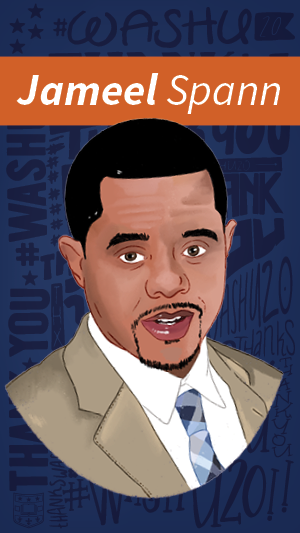
Jameel Spann
Thank you, Jameel Spann, for reminding us that what defines a university, more than its campus or buildings, is its commitment to community and intellectual engagement.
In 2014, Spann was among the first group of students to enroll in the Washington University Prison Education Project (PEP), founded by professors Robert Henke and Margaret Garb at the Missouri Eastern Correctional Center in Pacific. This spring, he will graduate from University College with a bachelor’s degree in integrated studies.
“It has been a journey,” Spann said. “I am really blessed. I understand the magnitude of the opportunities that I’ve had.”
Spann spent five semesters with PEP. He took classes such as “Classical and Renaissance Literature” with Henke and “Freedom, Citizenship and American Culture” with Garb. He particularly credits Jami Ake’s “Introduction to Women, Gender and Sexuality Studies” with helping him understand “how the intersection of race, gender, identity, sexual orientation — all of these different layers to a person’s being — inform the ways they are treated.”
After coming home to St. Louis in March 2017, Spann worked for an electrical contractor, earned his commercial driver’s license and drove for a local asphalt company. In 2019, he joined the Alliance for Higher Education in Prison, which supports and advocates for prison education programs.
He also became the first student to make the transition from PEP to the Danforth Campus. He points to a long line of faculty and staff mentors, including Barbara Baumgartner, Jennifer Hudson, Geoff Ward and Clarissa Hayward. He cites Hayward’s course “Power, Justice and the City” and Ward’s course “Histories and Legacies of Structural Racial Violence” as inspirations for his own thesis project, which centers on residential segregation.
“Residential racial segregation impacts educational outcomes — how well people do, how far they go in school — which, of course, impacts income and earning potential,” Spann explained. “[Sociologist] Charles Tilly called it ‘durable inequality.’ It’s built into the geographic and social infrastructure. Poor health outcomes, population decline, high rates of vacancy … These are not just accidents.”
After graduation, Spann will join his fiancé, a former high school sweetheart, and their two children in Nashville, Tenn. He also plans to pursue a law degree.
“What better way to effect change than to know the law, to immerse yourself in it?” he asked. “At WashU, I realized that, with the vantage points I’ve had, I can really contribute to that conversation.
“Without a diverse set of perspectives, we’ll just continue the cycles we have,” Spann concluded. “We won’t see real results.”
— Liam Otten
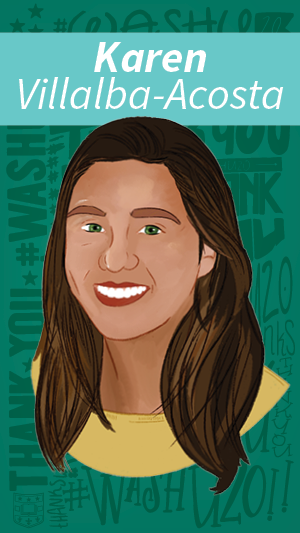
Karen Villalba-Acosta
Thank you, Karen Villalba-Acosta, for bursting the “WashU bubble.”
Karen Villalba-Acosta knew little about St. Louis when she arrived at Washington University as an Annika Rodriguez Scholar, Judy and Jerry Kent Scholar and Olin Business School Distinguished Scholar. But she has embraced her new home, immersing herself in the salsa dancing scene and serving local businesses.
“St. Louis is not just a location, it is the community that sustains us,” said Villalba-Acosta, a Michigan native. “Some of my best experiences happened far away from campus. The people here have taught me so much, and I hope I’ve given back in return.”
One such person is Kendra Cosey, owner of Her Best Virgin Hair Extensions in Florissant. Through the Small Business Initiative Program, Villalba-Acosta led a team of Olin Business School students who helped Cosey develop a marketing plan, implement effective data-management practices and improve pricing and procurement strategies. Cosey said Villalba-Acosta’s work has continued to pay off during the COVID-19 crisis.
“The stronger relationships she helped me build with my clients especially matter now when I can’t provide them services,” Cosey said. “To Karen, I wasn’t a school project. She really cared about me and my business and the people I serve. She got it.”
Villalba-Acosta said her experience with Cosey reaffirmed her belief in the power of small business.
“The employment, the investment of capital — all of that creates value and boosts a community,” said Villalba-Acosta, who will work at Bain & Company in Dallas after graduation. “Big businesses have a role to play, but it’s the entrepreneurs like Kendra who spend money in the community, leave money in the community and care about the community.”
Villalba-Acosta studied more than economics and finance here. She also learned the steps and styles of salsa as a member of the WU Sauce salsa team. Villalba-Acosta choreographed performances for the annual Carnaval show in Edison Theatre and participated in monthly social dances at studios across the city.
“I joined WU Sauce Salsa to stay connected to my Hispanic heritage,” Villalba-Acosta said. “But it has also been a great way to be part of St. Louis life. Dancing with the same people month after month is the best way to make friends.”
— Diane Toroian Keaggy
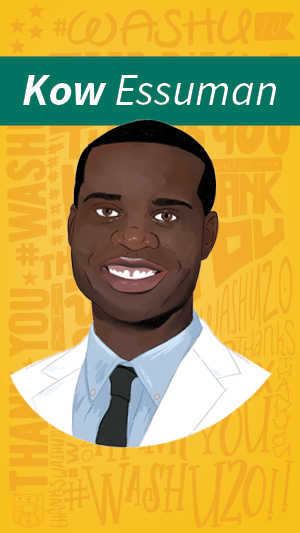
Kow Essuman
Thank you, Kow Essuman, for researching how nerve cells die to help find new ways to treat people with neurodegenerative diseases.
Essuman expects to graduate with medical and doctorate degrees in May. He soon will begin a residency in neurosurgery at Massachusetts General Hospital, which is affiliated with Harvard Medical School. Twice named a fellow of the prestigious Howard Hughes Medical Institute’s (HHMI) Medical Research Fellows Program, Essuman has focused on ways to block nerve cell degeneration, a common factor in Alzheimer’s and Parkinson’s disease, and other debilitating conditions that affect millions of Americans.
“Through my education, particularly during medical school, I began to appreciate the notion of making a difference in the world and being a leader in a field, and I focused on how I might achieve those goals through high-risk, large-impact research that would improve human health,” Essuman said.
His research has significantly contributed to the discovery of a new family of enzymes, one of which is actively being targeted to block neurodegeneration. “Hopefully, these scientific contributions will continue in the next phase of neurosurgery and will buttress my clinical practice,” he said.
Essuman’s interest in becoming a physician-scientist started early during his schooling in Accra, Ghana, where he was influenced by his parents, who are university administrators, and three successful brothers. The family viewed education as the keystone for improving human health and happiness.
“At the end of day, I want to have a positive impact on human lives,” Essuman said. “For me, the desire is deeply informed by my Christian faith, in expressing love toward others.”
— Kristina Sauerwein
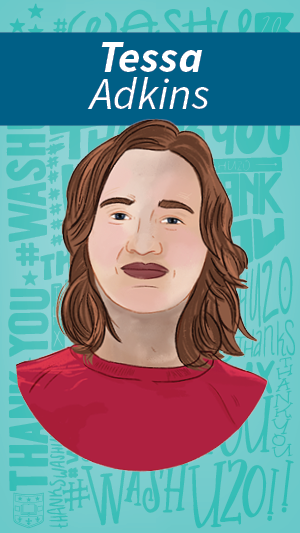
Tessa Adkins
Thank you, Tessa Adkins, for standing up for environmental justice.
Adkins is set to graduate next week from the Washington University School of Law, where she studied environmental law and was mentored by Maxine Lipeles of the Interdisciplinary Environmental Clinic. She loves bird watching, learning about trees and hiking in her native Kentucky. But that’s not why Adkins wants to be an environmental lawyer.
“To me, this work isn’t really about protecting the environment, but protecting humanity,” Adkins said. “Humans are, well, my favorite species of animal.”
During summer internships, Adkins fought companies whose negligence, she argued, put lives and livelihoods at risk. At the Appalachian Citizens’ Law Center in Kentucky, Adkins helped coal miners suffering from black lung disease, an illness caused by overexposure to dust particles in mines.
And at the Southern Environmental Law Center in Virginia, she was part of a team that prevailed against Atlantic Coast Pipeline developers who wanted to build near Union Hill, a historic community founded by freed slaves.
“There are a lot of losses in this field, so a win like that was really rewarding,” said Adkins, who will return to Appalachia after graduation to clerk for a federal magistrate judge in Huntington, W.V. “The stakes in these cases can be enormous because many of these communities have overburdened health-care systems without enough capacity to help people sickened by environmentally caused illnesses.”
Adkins has long struggled with the paradox of the coal industry. Her grandfather died in a coal mining accident when her father was a small boy, and her grandmother was left to fend for her five children alone. Yet, despite the boil water advisories and the workplace injuries, coal fueled the local economy and defined the town’s culture.
Today, as natural gas and renewable energies have become more competitive, the coal industry is shuttering mines and shedding jobs. Adkins does not know what’s next for residents left behind.
“But I do know this,” she said. “The costs that have been externalized onto us must be paid — and not by those who have suffered. The law is a potent force to make sure those who have been on the receiving end of this system are protected.”
— Diane Toroian Keaggy
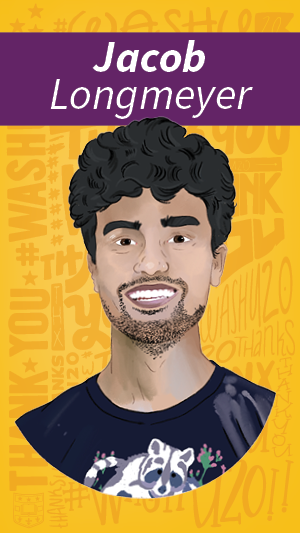
Jacob Longmeyer
Thank you, Jacob Longmeyer, for bringing the acorn muffins.
In middle school, Longmeyer asked his parents for a plant for Christmas.
“It’s called a pregnant onion, but it isn’t actually an onion,” Longmeyer explained. “It’s also not pregnant.” His unconventional gift request was granted, and by the end of high school, he had collected more than 80 plant species.
Longmeyer’s fascination with plants eventually led him to Tyson Research Center, where he has contributed to research projects and conservation efforts. He is set to graduate this month with a degree in environmental biology from Arts & Sciences.
Longmeyer began working at Tyson as part of a research group that studies interactions among soil organisms and plants. The next summer, he joined a landscape architecture project. Most recently, Longmeyer has taken a leadership role in the Tyson Conservation Corps (TCC), a student-led organization dedicated to conservation and ecological restoration.
“As TCC student coordinator during the 2019-2020 academic year, Jacob builds community among his peers and connects them with valuable training and networking opportunities,” said Solny Adalsteinsson, staff scientist at Tyson Research Center. “Importantly, he brings people together with a personal warmth that creates a welcoming community, whether by adding his artistic flair to events or baking tasty acorn muffins to share with the group.”
“A lot of people at WashU are not from St. Louis, so many of them aren’t familiar with this environment and the plants that grow around here,” Longmeyer said. “It’s cool to bring people out to Tyson and watch them become interested in the nature around them.”
Born in Rolla, Longmeyer’s family moved to Pleasant Hill, Mo., when he was in third grade. He said Tyson reminds him of the forests and hills he grew up around. He credits coursework with Doug Ladd, senior lecturer in environmental studies in Arts & Sciences and at the Sam Fox School, and a meaningful experience with the MARC USTAR program for helping to cement his research interests in ecology.
This summer, Longmeyer plans to work with Eleanor Pardini in Arts & Sciences, surveying an endangered lupine plant along the Point Reyes National Seashore, north of San Francisco. Then he will stay on at Point Reyes to work with the National Park Service for six months before applying to graduate school.
— Crystal Gammon
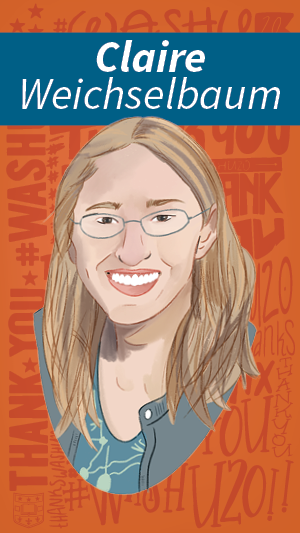
Claire Weichselbaum
Thank you, Claire Weichselbaum, for bringing the joy of science — and human brains — to St. Louis children.
Weichselbaum was always interested in science, although she didn’t know it. Memorizing facts wasn’t particularly exciting. But getting a pet was.
“When we got a dog, I was so fascinated by having this other, intelligent species that I couldn’t communicate with,” she said. “I had no idea what was inside his head.”
She wanted to know: what were animals — dogs, humans or otherwise — thinking? That’s when she discovered neuroscience. Working in a lab in college, getting hands-on experience as a scientist, she thought, “I’ve got to get kids exposed to this part of science when they’re younger.”
With the help of fellow neuroscience graduate student Brian Lananna, Brain Discovery was born.
The program pairs fourth, fifth and sixth graders with working scientists who visit once a week, for six weeks. Weichselbaum and Lananna chose those grades because research shows middle school is when someone decides that they are, or aren’t, a “science person.”
The kids get to see, and touch, a human brain, among other hands-on science. Students discover for themselves that one thing can be studied in different ways, from MRI images to looking at neurons under a microscope to electrophysiology.
“We’re not just teaching about the brain,” Weichselbaum said, “but the scientific process.”
In all, Brain Discovery has so far reached more than 1,500 students across more than 65 classrooms. The pair want to measure the program’s impact on student attitudes toward science. They will analyze and publish their results as a model for others to follow. Preliminary results, however, are positive.
Weichselbaum has written a curriculum and trained new leadership to ensure the program continues after she earns her PhD in neuroscience from the Graduate School this month. Between Brain Discovery and her studies, she doesn’t have time for much more.
Unless, of course, it has to do with animals.
“One thing that helps me stay sane is fostering cats for Stray Rescue of St. Louis,” she said. Weichselbaum has fostered 23 cats over the years.
Brain Discovery has benefited students in the area, but it also has been rewarding for the volunteers.
“It really helps them feel like they’re giving back to the community,” Weichselbaum said. “As you go through grad school, the focus gets narrower and you can lose the forest for trees. These experiences are helpful to help us remember why we’re doing science, and why it matters.”
— Brandie Jefferson
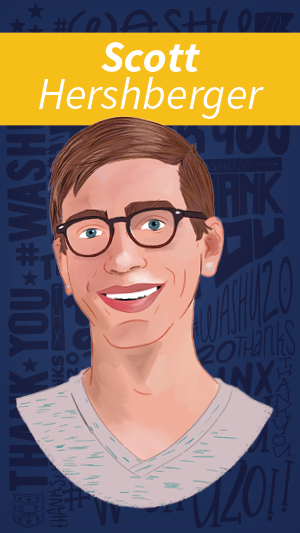
Scott Hershberger
Thank you, Scott Hershberger, for explaining it all so clearly.
For his first three years of college, Hershberger was aiming toward a future as a research professor. It was the default path for him, but it wasn’t a perfect fit.
“I love math and physics — it’s so cool to explore the most fundamental aspects of our universe — but it never felt quite right for me to make that my career,” Hershberger said. “I’ve become increasingly interested in how science travels from the lab bench to the public sphere, and increasingly worried by the disconnect in that process.”
Hershberger took an internship with The Ampersand his senior year, reporting on topics as diverse as molecular muscles and “emergent simplicity.” Based on this experience, Hershberger was awarded an AAAS Mass Media Fellowship to spend 10 weeks this summer writing for Scientific American. After that, Hershberger plans to enter a master’s program in science communication.
Hershberger was born in Colorado and grew up in Wichita, Kansas. A Compton Scholar at Washington University, he is set to graduate with a degree in math and physics, and a minor in Spanish, all in Arts & Sciences.
Math Club is Hershberger’s favorite extracurricular activity, but music is an important part of his life, too. He has played jazz piano and composed music since middle school, and he volunteers weekly teaching piano lessons with Orchestrating Diversity (now Sounds of St. Louis).
“One of the first moments when Scott really caught my attention was in the sophomore-level physics class, where I was teaching a lecture about Fourier transforms and using an audio spectrum analyzer,” said Kater Murch, associate professor of physics in Arts & Sciences. “I showed how it would give the frequency content of sound on the microphone, and I asked (jokingly) ‘can anyone give me a C?’ And before I knew it, there was Scott, singing a perfectly in-tune C, with it displaying beautifully on the spectrum.”
Hershberger went on to conduct research in Murch’s quantum physics laboratory.
Hershberger hopes that clear science communication can help society tackle urgent problems.
“The fact that so many people reject the evidence that climate change is occurring is just one example of the failures in communication between academia and the general public.
“More than ever, we need a dialogue,” Hershberger said. “We need scientists to communicate not just what they found, but also how and why.”
— Talia Ogliore
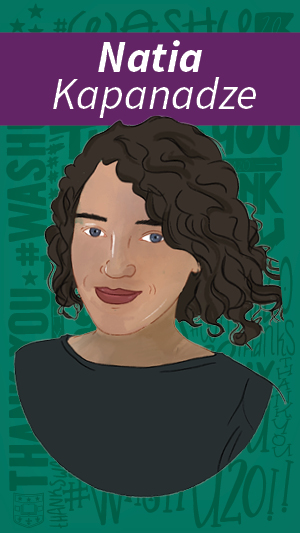
Natia Kapanadze
Thank you, Natia Kapanadze, for helping us see the natural world with fresh eyes.
Born and raised in the Republic of Georgia, Kapanadze studied landscape architecture at the Tbilisi State Academy of Arts, then spent two years on staff at the National Botanical Garden. She supervised plantings, coordinated events and helped organize the garden’s first national Green Expo.
But “landscape architecture is a fairly new field in Georgia,” she says. Projects were typically limited in scale: the park, the yard, the patio. “The mindset was very narrow. I wanted to expand it. I wanted to experience new environments and different communities.”
As a Master of Landscape Architecture candidate in the Sam Fox School of Design & Visual Arts at Washington University in St. Louis, Kapanadze has turned her sights to the scale of the street, the river, the watershed. Last fall, she won an American Society of Landscape Architects student merit award for a speculative project that would use strategic regrading and plantings at the Ohio and Mississippi river confluence to reduce nitrogen flow into the Gulf of Mexico.
With classmate Samuel Bell-Hart, Kapanadze also spent months investigating how the Public Land Survey System (a.k.a. the Jeffersonian Grid) has reshaped sedimentation and settlement patterns across the upper Mississippi. The resulting maps, laser-scored onto plexiglass, were featured in a pop-up exhibition atop a Continental Cement Company silo on the river north of downtown.
Other projects include designing information boards for the university’s Office of Sustainability and producing videos in conjunction with the Mildred Lane Kemper Art Museum exhibition “Ai Weiwei: Bare Life.” With classmate Lauren McDaniel, Kapanadze organized a screening of videos, created for assistant professor Eric Ellingsen’s “Visualizing Ecological Processes” course, at the Griot Museum of Black History. Her degree project, “Soundscapes,” investigates ways to re-introduce natural sounds into urban environments currently dominated by traffic noise.
“WashU is very experimental,” she says. “It offers a set of tools and techniques but also allows you to explore your own interests — and not only at the theoretical level. You can go out to the floodplains, study the confluences, and see how the city is divided. It’s a great place to get a broad understanding of the field.”
— Liam Otten
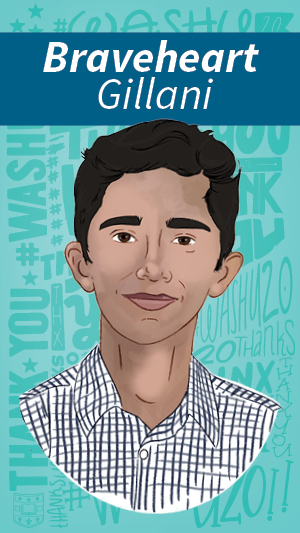
Braveheart Gillani
Thank you, Braveheart Gillani, for answering the call to serve society through social work.
A decade ago, Braveheart was a subsea engineer assigned to the Deepwater Horizon rig team when the oil well exploded, killing 11 workers and setting off one the world’s greatest environmental disasters. The tragedy prompted Braveheart to reevaluate a career that was both dangerous and fraught.
“There were many times during my offshore career where I experienced narrow brushes with death,” he recalled. “Those instances made me take a pause and wonder, ‘Was my life spared for some reason? Are there more meaningful problems than optimizing oil and gas production that I can help solve?’”
Those questions led Braveheart to the Social Systems Design Lab at the Brown School at Washington University in St. Louis, where he has worked on system dynamics models to better predict policy outcomes and helped facilitate modeling sessions across various communities. To Braveheart, process matters.
“It’s hard to find solutions when you don’t understand the problem,” he said. “Community-based system dynamics helps us break out of our silos to better understand the mental models of others and clearly visualize systems driving our society. It allows us to identify interventions and potentially avoid unintentional negative consequences of new interventions.”
Braveheart has shared his Brown School training with students across campus, serving at the Center for Diversity and Inclusion and the Relationship and Sexual Violence Prevention Center. He is also part of the first cohort forthe St. Louis Queer + Support Helpline (SQSH) and served as an adviser to the Men’s Project, a student group which helps men examine concepts of masculinity.
After graduation, he will pursue his PhD at Case Western Reserve University in Cleveland, where he plans to utilize system dynamics to research issues that impact the queer community. It is work he is honored to perform during this time of crisis.
“We, as a larger community, are experiencing isolation for perhaps the first time, but this is nothing new to minority communities,” he said. “So when you look at queer and marginalized communities, we’ve always been isolated. My hope is this pandemic enhances the larger society’s ability to understand and empathize with those who are struggling. I hope it builds a bridge.”
*Braveheart Gillani prefers to be referred to by his first rather than last name.
— Diane Toroian Keaggy
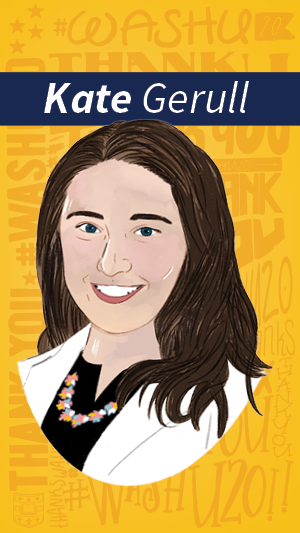
Kate Gerull
Thank you, Kate Gerull, for supporting the advancement of women and underrepresented minorities in the medical field.
Gerull is poised to earn a medical degree in May and begin a residency in orthopedic surgery at Barnes-Jewish Hospital in July. Already, she has achieved national recognition as one of five female students who co-founded the organization 500 Women in Medicine in late 2018. The advocacy project, which has since merged with 500 Women Scientists, created an international database of female physicians and scientists qualified to serve as expert resources for media outlets, professional recruitment committees, conference organizers and other sources that raise career visibility and networks.
“It is imperative that women and underrepresented minorities rise to leadership roles in medicine,” said Gerull, who has published research in academic journals and written articles for lay publications detailing gender and racial biases in health care. “To truly serve patients, the medical field must be inclusive and reflect the diversity of our society.”
Her research questions and nonprofit work were a direct response to her experiences in the health-care environment. “Intimidating statistics would tell me it was not feasible to pursue certain careers,” she said. “But I had to press forward in order to change the statistics.”
Take, for example, orthopedic surgery, “one of the least gender- and racially diverse specialties in medicine,” Gerull said. “People would say to me, ‘Are you strong enough to do orthopedics?’ And, ‘You’re not an athlete. How are you going to understand orthopedic problems?’ And, ‘You don’t look like an orthopedic surgeon. Or any kind of surgeon.’”
Gerull found it odd that no one said that to her husband, fellow graduating medical student Will Gerull, who will begin a general surgery residency at Barnes-Jewish Hospital in July.
“Why do people feel the need to say it to me because I’m a woman?” Gerull asked. “This has motivated my passions. Think of all the women and underrepresented minorities who stop because the statistics are against them, or because someone tells them they can’t achieve their goals. I want to be the person who looks like them, talks like them and says to them, ‘You can do this because I did.’”
— Kristina Sauerwein
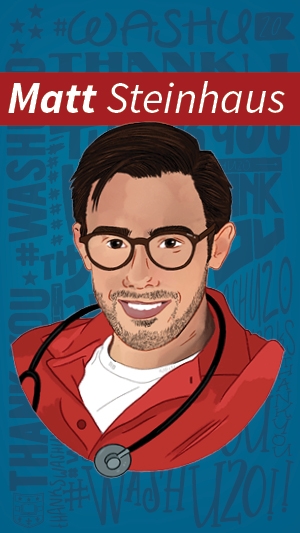
Matt Steinhaus
Thank you, Matt Steinhaus, for your courage on the front lines and your excellence in the classroom.
Steinhaus is a paramedic, transporting patients to the hospital and responding to 911 calls. A month ago, he answered maybe one or two coronavirus calls a week. Now it’s one or two a day.
“You have to be totally gowned up,” explained Steinhaus, who has been a paramedic for nine years. “You spend a good 45 minutes after each call making sure you totally decontaminate everything, and then another hour after that terrified to touch your face.”
It’s important work. It’s rewarding work. But it’s not Steinhaus’ passion. Politics is.
“I’ve always been a political junkie and am curious about political behavior,” Steinhaus said. “I’m really curious about how we create our political identities and how those identities influence how we act and how we see the world.”
Steinhaus explored those questions at University College at Washington University in St. Louis, where he is in line to earn a bachelor’s degree in political science and in psychology from Arts & Sciences. Steinhaus also has been awarded the Dean’s Award for Academic Excellence, the highest academic honor for a graduating undergraduate, and earned Latin honors for his research thesis into white identity politics.
“To complete an undergraduate degree while also working as a paramedic is an accomplishment in and of itself, but Matt is a stand-out student for so many reasons — his strong command of social psychology and political science, his conscientiousness and creativity and, absolutely, his passion,” said Erin D. Solomon, Steinhaus’ research adviser and staff scientist at the School of Medicine.
After graduation, Steinhaus will continue to serve as a paramedic. Ultimately, he hopes to move to Washington, D.C. To do what, he’s not yet sure. His coursework in political science has prepared him for a career in electoral politics. Or he could leverage his expertise in statistics to work as a pollster. Or he could bring his research skills to a think tank.
“Thanks to the opportunities I’ve had here, a lot of options seem open to me,” Steinhaus said.
— Diane Toroian Keaggy
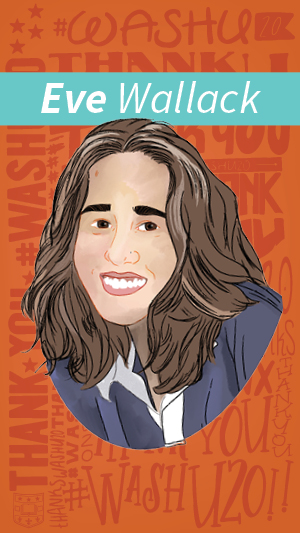
Eve Wallack
Thank you, Eve Wallack, for reminding us that art and design are communal activities.
“There’s a lot of power in visual communication,” said Wallack, who will earn her bachelor of fine arts in communication design from the Sam Fox School of Design & Visual Arts. “I try to use design as a tool for thinking about larger social issues. What needs to be said, and what needs to be heard?”
As an executive board member for City Faces, the mentoring nonprofit based in St. Louis’ Clinton-Peabody housing complex, Wallack created promotional materials, launched the group’s first Instagram account and spearheaded a social media fundraising campaign that raised $7,000 in less than a week.
While interning for the Sam Fox School’s Office for Socially Engaged Practice, she and fellow intern Lyle Hansen (MArch/MUD ’19) developed the Community Art Wall, a public art project installed on fencing around the east end construction site. Inspired by visiting artist Candy Chang, Wallack and Hansen asked passers-by to respond to a pair of prompts: “I heard St. Louis is … And to me, St. Louis is … .”
“It was a lot of work getting approved, but it was cool to see how people used the wall to express their feelings and engage in different ways,” Wallack said. “One night, I saw somebody drawing a dragon! Just having the wall as a place to communicate was really fun.”
As an orientation counselor with the Gephardt Institute for Civic and Community Engagement, Wallack helped introduce incoming students to the larger St. Louis community. This semester, she served as a teaching assistant for the “Law, Race and Design” course, which explored issues of access and equality.
With her design capstone project, “The Periodical,” Wallack hopes to raise awareness about the barriers some women face in securing menstrual products. Wallack and classmates in the “Design for Social Impact” class recently worked with St. Louis Children’s Hospital to develop an informational pamphlet about treatments for craniosynostosis, a medical condition in which the bones in an infant’s skull begin fusing too quickly.
“I consider myself a creative person, but I’ve always been more interested in what’s going on out there in the world,” Wallack concluded. “How can I be a voice for others? How can I use design to highlight issues we may not see and present complex information in a meaningful way?”
— Liam Otten
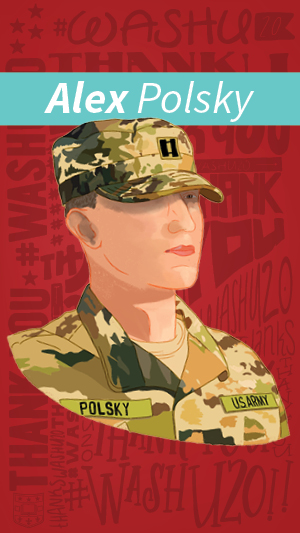
Alex Polsky
Thank you, Alex Polsky, for your commitment to public service.
Alex Polsky will graduate from the School of Law after completing externships at the St. Louis Circuit Attorney’s Office and the U.S. Attorney’s Office in his home state of New Jersey. He also is a company commander in the U.S. Army Reserve’s Civil Affairs unit and served as an Infantry officer.
“Alex has thrived in many roles because he has an innate ability to assess where help is needed most and where there is the opportunity for change,” said Mahrya Fulfer Page, director of judicial clerkships and student engagement at the School of Law and a former assistant circuit attorney for St. Louis. “He doesn’t just think about a solution for an immediate problem; he thinks about the impact that will have on other issues as well.”
Polsky says the academic, financial and professional support he received from the School of Law has prepared him for the next steps in his career. After graduation, Polsky will join the law firm Paul, Weiss in New York City and then hopes to return to the U.S. Attorney’s Office before ultimately applying his legal training and leadership skills to public policy.
The child of public servants — his mother was a state and federal prosecutor; his father is a professor and dean in the City University of New York system — Polsky believes in the transformative power of good government.
“I am interested in the big questions — how can we design better policies to have better outcomes for all,” Polsky said. “Sometimes the answer is better laws, but not always.”
Take the COVID crisis, he said. We can and should enact laws to protect public health. But what if no one follows them?
“Law is the backstop mechanism to force people to do things when nothing else works, but the goal is to guide people to want to make good individual choices that are best for society,” Polsky said. “And that requires leaders.”
— Diane Toroian Keaggy
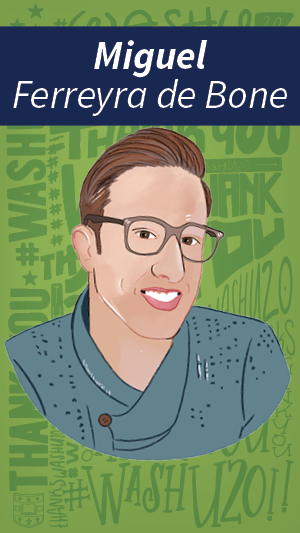
Miguel Ferreyra de Bone
Thank you, Miguel Ferreyra de Bone, for working to encourage broader diversity in Olin classrooms.
As the Graduate Business Student Association president, Ferreyra de Bone worked collaboratively with the student government leadership team and Olin Business School administration to tackle an ambitious agenda that included rewriting the GBSA constitution and operating structure. “Miguel always leads with wanting the best for others and through his excellent leadership, was able to make a significant impact on students and staff at Olin,” said Ashley Macrander, associate dean and director of student affairs for the Olin graduate programs.
His proudest accomplishment, though, is leading the effort to reactivate the diversity and inclusion committee.
In recent years, Olin has made gains in hiring diverse faculty members. The school is ranked in the top four globally for best full-time MBA programs for women, but Ferreyra de Bone said students wanted to see more female faculty in the classroom.
“I listened to my colleagues and it was clearly important that women who come to Olin to learn have role models who they could look up to,” he said. “Diversity in the classroom — whether gender, race, background or sexual orientation — benefits everyone. It brings different conversations, voices and experiences to our learning.”
Serving as the GBSA president provided Ferreyra de Bone with the opportunity to develop his leadership abilities. “When you have 300 people asking questions and looking to you for solutions, you learn how to listen, prioritize, speak your opinion and how to say no. You also learn to have thick skin,” he said. “I’m glad I’m graduating with these executive skills.”
While at Olin, Ferreyra de Bone, who is from Argentina, studied in Israel, Tokyo and Seoul, where he developed a keen understanding of the forces that shape the global economy. He also worked as a summer associate at St. Louis-based HBM Holdings, where he executed platform acquisitions, including a more than $100 million deal, and crafted investment theory around the firm’s renewable energy strategy.
— Sara Savat
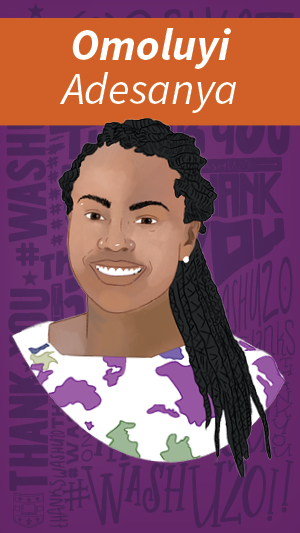
Omoluyi Adesanya
Thank you, Omoluyi Adesanya, for making the world a healthier place.
Omoluyi Adesanya is a master’s of public health and of business administration dual-degree candidate with a focus on global health.
“With my interests in the preventative health and business sector, I am hoping to pursue a career that allows me to improve health outcomes and strengthen health systems in emerging markets throughout the developing world,” she said.
A daughter of Nigerian and German immigrants, Adesanya is incredibly proud of the opportunity to earn a graduate degree from Washington University in St. Louis in the MPH/MBA program.
“As we look at present-day societal issues in the field of social work, social policy and public health, our academic fields as master’s and doctoral students are needed to make substantial impact and civic engagement to fix the many disparities and inequities that continue to persist across generations,” she said.
After graduating, Adesanya looks forward to attending a doctoral training program and furthering her interests in public health, translational research, and dissemination and implementation sciences.
“I am thankful for my time at WashU as a dual-degree graduate student, as it has provided me a wealth of knowledge and rigor for making an impact in the field of public health and business as an aspiring public health practitioner,” she said.
Although she hoped her time at the university would end on a more positive note, “it is evident that the COVID-19 pandemic has shed light on the importance of our field as future public health professionals.”
“I am able to see the great complexities of public health and the economy, as well as the negative ramifications of social welfare and health inequities that continue to persist in our society,” Adesanya said. “As a future practitioner in the field of public health, coupled with my MBA, I hope to give back and make an impact in the field, especially for vulnerable underserved populations, such as the one from which I came.”
— Neil Schoenherr
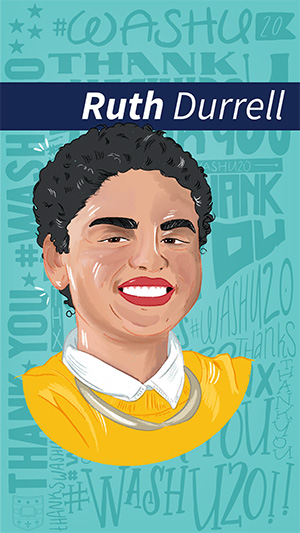
Ruth Durrell
Thank you, Ruth Durrell, for making Washington University a place where low-income students can thrive.
As an Ervin Scholar, Durrell received a full scholarship to WashU. But her experiences and studies in education and in sociology in Arts & Sciences taught Durrell that money is not enough.
“Low-income students need mentors who can help them navigate their way on campus and academic resources — not because we aren’t as talented, but because we often did not have access to the programs and schools our peers did,” Durrell said. “But most importantly, we need a support network of our peers.”
Durrell has helped deliver all of the above to Washington University through her service to the Deneb STARS program, an innovative cohort program for low-income and first-generation students.
“We shared a vision of what this program could be,” said Anthony Tillman, assistant provost for student success, who launched the program in 2016. “Her strong sense of self shows Denebs that their backgrounds and identities are not a deficit, but a source of cultural wealth.”
It’s a message Durrell, also a Civic and Enterprise scholar, has shared with the Board of Trustees, where, as a student representative, she has advocated for the university to recruit, accept and support more low-income students.
And it’s one she has shared with the young students at Humboldt Elementary School, where she and fellow members of WU-SLAM taught slam poetry.
“I was there to show them the power of writing and performing, but I also considered it my job to inspire the students to strive for college. And not just any college, but a good one,” said Durrell, who will work in Milwaukee Public Schools as part of the City Year program. “By the end of it, they would say, ‘I’m going to go to WashU.’ And I would answer, ‘Yes. Yes you are.’”
— Diane Toroian Keaggy
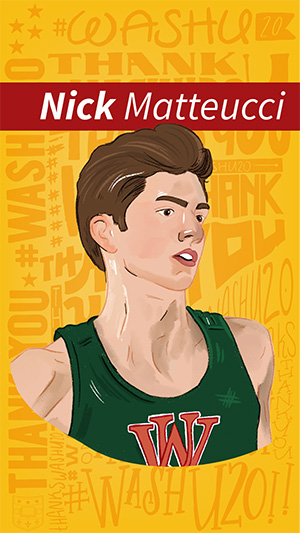
Nick Matteucci
Thank You, Nick Matteucci, for being a leader on the track and in the locker room.
A nine-time NCAA All-American, Matteucci led Washington University in St. Louis’ cross-country and indoor track teams to their best finishes in Bear history and set a school record in the 1,500-meter run in outdoor track and field.
But for Matteucci, the team matters more than the trophies.
“As a runner, there’s always another race, another personal record to chase,” said Matteucci, who is earning a bachelor’s degree in chemical engineering from the McKelvey School of Engineering and will pursue a PhD in the same discipline. “If that’s all that matters, you will never be satisfied. The joy, for me, comes from putting it all out there for my teammates.”
That attitude is what makes Matteucci among the most selfless servant leaders Jeffrey Stiles, head coach of the track-and-field and cross-country teams, said he has had the privilege to coach.
“He loves the team, he hates to lose and his competitive intuition is second only to his academic prowess,” Stiles said. “It’s hard when your senior indoor and outdoor seasons are stripped away, especially since he had the team primed to win the indoor title. But he has shown his teammates that their bonds are what matter.”
Matteucci also is committed to his runners on the Bear Cubs Running Club, which pairs varsity athletes with children on the autism spectrum. One of his runners went on to join his middle school team. Another, who started the program unable to complete a lap around Francis Field without walking, now can run a mile without stopping.
“It is incredible to see their enthusiasm when they set and achieve their goals,” Matteucci said. “To be able to use something I’m really passionate about — running — to help others is the best thing.”
— Diane Toroian Keaggy
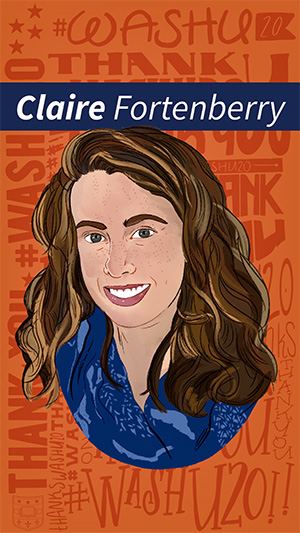
Claire Fortenberry
Thank you, Claire Fortenberry, for doing your part to improve the air we breathe.
Fortenberry is set to graduate with a PhD in energy, environmental and chemical engineering from the McKelvey School of Engineering. For six years, she has worked in Brent Williams’ Atmospheric Chemistry and Technology Lab, where she has built equipment to measure indoor and outdoor air quality.
Williams is the Raymond R. Tucker Distinguished InCEES Career Development Associate Professor.
“Equipment can be expensive and difficult to transport to places where it matters most,” Fortenberry said. “We’ve managed to build an instrument that measures a wider variety of pollutants and we’ve used it to gain a better understanding of different particles and gases in the air we breathe. It’s been challenging — instrument development is hard, things break. But there is nothing more empowering than taking something that’s broken and making it work.”
Growing up in Virginia, Fortenberry wanted to save lives. Medicine seemed the obvious choice, but she realized her skills in physics and chemistry would allow her to tackle one of the globe’s biggest threats to human health: pollution. According to the World Health Organization, some 7 million people die prematurely due to indoor and outdoor air pollution.
“It blows my mind how much air quality makes a difference in people’s lives,” Fortenberry said. “We mostly understand the impact of outdoor air pollution, but indoor pollutants also impact our health in ways that aren’t easy to predict. The time of day you cook, what cleaning supplies you use, even an open window — all of these can detract from your indoor air quality.”
After graduation, Fortenberry plans to begin work at the NASA Glenn Research Center in Cleveland, where she will study a different type of atmosphere: space. NASA has charged her with improving fire safety on the International Space Station by researching how smoke particles are formed and move in a microgravity environment. Fortenberry is up to the task.
“I can’t believe how much I’ve learned here,” Fortenberry said. “I have my colleagues and adviser to thank for that. But this work required me to teach myself things I had no idea I would be doing.”
— Diane Toroian Keaggy